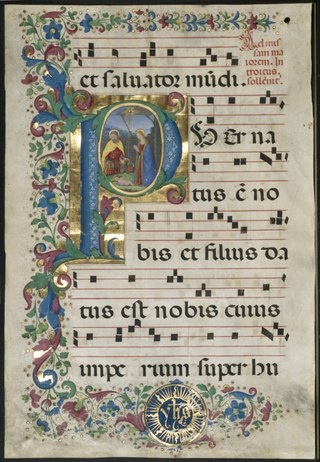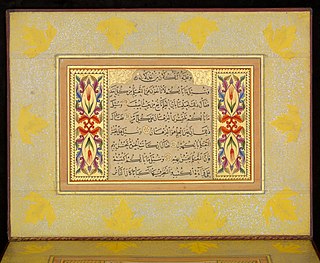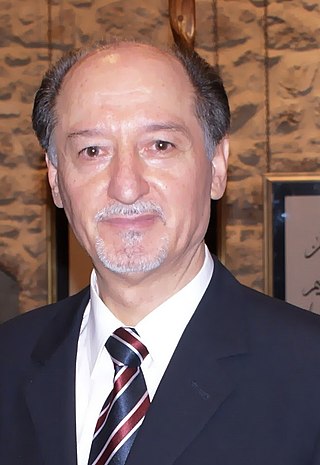
Abdul Rahman Hilmi (died 1805) was a Turkish calligrapher.

Abdul Rahman Hilmi (died 1805) was a Turkish calligrapher.
Abdul Rahman Hilmi was pupil of Egrikapili Mehmed Rasim Efendi. He was an adroit calligrapher, known for the firmness of his writing. He spent most of life in Hagia Sophia school in Istanbul studying calligraphy and training students. [1] [2]
Hilmi was remembered as a very moral and praiseworthy person. He died in 1220/1805 and was buried in Scutari, in the vicinity of another great calligrapher, Sheikh Hamdullah. [3]

Calligraphy is a visual art related to writing and is the design and execution of lettering with a pen, ink brush, or other writing instrument. Contemporary calligraphic practice can be defined as "the art of giving form to signs in an expressive, harmonious, and skillful manner".

Nastaliq, also romanized as Nastaʿlīq or Nastaleeq, is one of the main calligraphic hands used to write the Perso-Arabic script in the Persian, Urdu and Punjabi (Shahmukhi) languages, often used also for Ottoman Turkish poetry, rarely for Arabic. Nastaliq developed in Iran from naskh beginning in the 13th century and remains very widely used in Iran, Afghanistan, India and Pakistan and other countries for written poetry and as a form of art.

Islamic calligraphy is the artistic practice of handwriting and calligraphy, in the languages which use Arabic alphabet or the alphabets derived from it. It includes Arabic, Persian, Ottoman, and Urdu calligraphy. It is known in Arabic as khatt Arabi, which translates into Arabic line, design, or construction.

Claude Cahen was a 20th-century French Marxist orientalist and historian. He specialized in the studies of the Islamic Middle Ages, Muslim sources about the Crusades, and social history of the medieval Islamic society.

Hassan Massoudy, born in 1944, is an Iraqi painter and calligrapher, considered by the French writer Michel Tournier as the "greatest living Calligrapher", currently lives in Paris. His work has influenced a generation of calligraffiti artists.

Seyyid Kasim Gubari of Diyarbakır was a 17th-century Ottoman artist, noted for his poetic writing and calligraphy. He is celebrated as one of the most accomplished calligraphers of his time and decorated a number of important public buildings including the Blue Mosque in Istanbul.
Muhaqqaq is one of the main six types of calligraphic script in Arabic. The Arabic word muḥaqqaq (محقَّق) means "consummate" or "clear", and originally was used to denote any accomplished piece of calligraphy.

Sheikh Hamdullah (1436–1520), born in Amasya, Ottoman Empire, was a master of Islamic calligraphy.

Turkish art refers to all works of visual art originating from the geographical area of what is present day Turkey since the arrival of the Turks in the Middle Ages. Turkey also was the home of much significant art produced by earlier cultures, including the Hittites, Ancient Greeks, and Byzantines. Ottoman art is therefore the dominant element of Turkish art before the 20th century, although the Seljuks and other earlier Turks also contributed. The 16th and 17th centuries are generally recognized as the finest period for art in the Ottoman Empire, much of it associated with the huge Imperial court. In particular the long reign of Suleiman the Magnificent from 1520 to 1566 brought a combination, rare in any ruling dynasty, of political and military success with strong encouragement of the arts.

Gelibolulu Mustafa Âlî bin Ahmed bin Abdülmevlâ Çelebi was an Ottoman historian, bureaucrat and major literary figure.

Hâfiz Osman (1642–1698) was an Ottoman calligrapher noted for improving the script and for developing a layout template for the hilye which became the classical approach to page design.

Yaqut al-Musta'simi (Arabic: ياقوت المستعصمي) was a well-known calligrapher and secretary of the last Abbasid caliph.

Derviş Ali was a 17th-century Ottoman calligrapher.

İsmail Zühdi Efendi was an Ottoman calligrapher. “Efendi” is a title of nobility, so this name can also be rendered İsmail Zühdi.
Kazasker Mustafa Izzet Efendi, was an Ottoman composer, neyzen, poet and statesman best known for his calligraphy.

Mehmed Esad Yesari was an 18th-century Ottoman calligrapher known as the greatest calligrapher of his age.

Hassan Sobhi Mourad was an academic, a calligrapher, an artist, a researcher, an author and a poet. He specialized in Arabic calligraphy, its development and teaching, drawing to all age groups, as well as contributing in writing art-related articles. Born in Syria, Hassan Mourad lived abroad in various countries and continents for over thirty-five years due to his career in diplomatic service. Though living abroad for most of his adult life, he remained passionate about the Arabic Language, its history and the art of Arabic Calligraphy. Mourad was influenced at the early age of 14 by a fellow Syrian writer without having ever met him; this artist, AbdulRahman Fakhoory, predicted a bright future in art for Mourad.

Hashem Muhammad al-Baghdadi (1917–1973) was an Iraqi master calligrapher, noted for his lettering which exhibited a steadiness of hand and fluidity of movement. In his later life, he was acknowledged as the "imam of calligraphy" across the Arab world, and would be the last of the classical calligraphers. He also authored several important texts on the art of calligraphy.